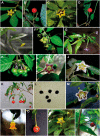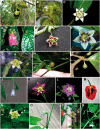Phylogenetic relationships, diversification and expansion of chili peppers (Capsicum, Solanaceae)
- PMID: 27245634
- PMCID: PMC4934398
- DOI: 10.1093/aob/mcw079
Phylogenetic relationships, diversification and expansion of chili peppers (Capsicum, Solanaceae)
Abstract
Background and aims: Capsicum (Solanaceae), native to the tropical and temperate Americas, comprises the well-known sweet and hot chili peppers and several wild species. So far, only partial taxonomic and phylogenetic analyses have been done for the genus. Here, the phylogenetic relationships between nearly all taxa of Capsicum were explored to test the monophyly of the genus and to obtain a better knowledge of species relationships, diversification and expansion.
Methods: Thirty-four of approximately 35 Capsicum species were sampled. Maximum parsimony and Bayesian inference analyses were performed using two plastid markers (matK and psbA-trnH) and one single-copy nuclear gene (waxy). The evolutionary changes of nine key features were reconstructed following the parsimony ancestral states method. Ancestral areas were reconstructed through a Bayesian Markov chain Monte Carlo analysis.
Key results: Capsicum forms a monophyletic clade, with Lycianthes as a sister group, following both phylogenetic approaches. Eleven well-supported clades (four of them monotypic) can be recognized within Capsicum, although some interspecific relationships need further analysis. A few features are useful to characterize different clades (e.g. fruit anatomy, chromosome base number), whereas some others are highly homoplastic (e.g. seed colour). The origin of Capsicum is postulated in an area along the Andes of western to north-western South America. The expansion of the genus has followed a clockwise direction around the Amazon basin, towards central and south-eastern Brazil, then back to western South America, and finally northwards to Central America.
Conclusions: New insights are provided regarding interspecific relationships, character evolution, and geographical origin and expansion of Capsicum A clearly distinct early-diverging clade can be distinguished, centred in western-north-western South America. Subsequent rapid speciation has led to the origin of the remaining clades. The diversification of Capsicum has culminated in the origin of the main cultivated species in several regions of South to Central America.
Keywords: Capsicum; South America; chilli peppers; dysploidy; flowering features; geographical expansion; phylogeny; pungency.
© The Author 2016. Published by Oxford University Press on behalf of the Annals of Botany Company. All rights reserved. For Permissions, please email: journals.permissions@oup.com.
Figures







References
-
- Acosta MC, Bernardello G, Guerra M, Moscone EA. 2005. Karyotype analysis in several South American species of Solanum and Lycianthes rantonnei (Solanaceae). Taxon 54: 713–723.
-
- Antonelli A, Sanmartín I. 2011. Why are there so many plant species in the Neotropics? Taxon 60: 403–414.
-
- Baral JB, Bosland PW. 2004. Unravelling the species dilemma in Capsicum frutescens and C. chinense (Solanaceae): a multiple evidence approach using morphology, molecular analysis, and sexual compatibility. Journal of the American Society of Horticultural Sciences 129: 826–832.
Publication types
MeSH terms
Substances
LinkOut - more resources
Full Text Sources
Other Literature Sources
Miscellaneous

